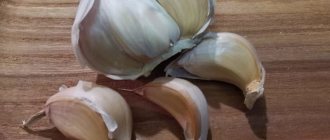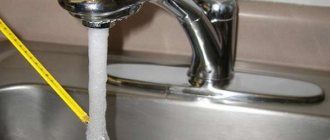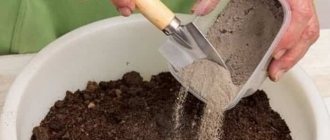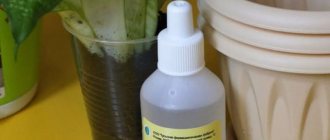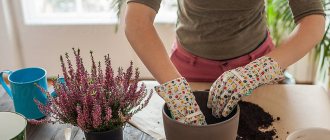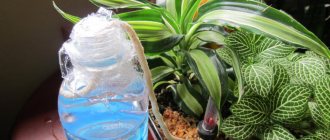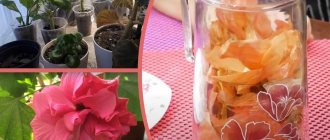Is it possible to water flowers with water from an air conditioner?
The condensate formed during operation of the air conditioner is distilled water. The distillate is completely devoid of mineral salts, which is even good for some flowers. Such a liquid would be useful for watering epiphytes (the same orchids) and predator plants.
However, in this case, the aquatic environment is filled with fine dust and all kinds of bacteria that have entered it from the air. Purely theoretically, water from expensive air conditioners with good filters may be of higher quality, but the validity of this version can only be confirmed in a laboratory.
How to arrange flowers correctly?
Any plant requires good care and respect. Before placing roses cut from a flower bed into water, they must be treated. First of all, pay attention to what appearance the plant has. If it is fresh, all actions must be performed very quickly, without wasting time. Only in this case will the roses be able to last for at least 3 weeks.
Please note that if the flowers were given in winter, they cannot be placed in water immediately; they must first be warmed at room temperature. Next you need to trim the stems a little. This must be done carefully, using pruning shears. The cut should be made at an angle, and air should not get into it. That is, this action is performed under running water.
You will also need to make a deep cross-shaped cut at the end of each stem. Be sure to remove all excess leaves and thorns from the part of the flower that will be under water. Otherwise, they will rot and the plant will wither very quickly.
Mineral water for irrigation
In the case of mineral water, it all depends on what plants live in the house. If these are epiphytes, cacti and other succulents, such watering is contraindicated for them. Mineral sparkling water contains too many salts, and desert dwellers require poor soil similar to what is available in nature.
For ordinary indoor plants, such as begonias and pelargoniums, such watering is acceptable as a one-time measure. That is, they are not watered with mineral water constantly, but from time to time. Before this, you need to release the gas from the bottle by removing the cap and waiting 10-15 minutes. Carbon dioxide bubbles can damage plant roots, so you need to get rid of them.
Flowers should absolutely not be watered with sweet soda. Plain water with sugar can be used as an infrequent feeding. Apply it once a month. Glucose accelerates photosynthesis, which has a positive effect on plant growth. The fertilizer is suitable for home roses, ficuses, and cacti. Prepare a solution from 1 tbsp. l. sugar per 1 liter of water.
Is it possible to water indoor flowers with serum?
Whey is very beneficial for plant growth. It saturates the root system with useful organic and mineral substances. If the roots receive good nutrition, then the above-ground part of the bushes will be healthy.
Indoor plants and beautiful home flowers
Irrigation with serum is an indispensable and effective prevention against fungal infectious diseases. The product works no worse than special fungicide preparations designed to combat pests and diseases.
Note! Do not water indoor plants with undiluted serum in its pure form. Otherwise, burns will appear on the leaf plates. The product is dissolved in water in a ratio of 3:1.
Tea is good for plants
What happens if you pour boiled and hot water on it?
In most Russian cities, the water flowing from the tap has increased hardness. As a result, after watering, plant roots suffer, and the surface of the soil becomes covered with a salt crust over time.
We recommend: Why do indoor plants feel cramped in a pot and how do you know when it’s time to replant them?
By watering plants with boiled water, you can get rid of the problem factor. It is first left to sit for 2-3 days to saturate it with oxygen. With this method of watering, the soil in pots must be loosened regularly so that air can reach the roots.
Professionals advise using hot water to water plants that do not bloom for a long time or refuse to grow. Actually, it should not even be watering, but a shower. The heating temperature is no more than 38° C, otherwise the flowers will “cook”. What's the trick here?
This procedure will become stressful for the plant and will bring it out of the state of unplanned sleep. At the same time, water jets will wash away pests, if any, from the flower. The shower cannot be used for specimens that have pubescent leaves (violets, begonias).
Is it worth watering?
Despite the direct ban on most sources, there are flower growers who irrigate with water directly from the well.
It is forbidden
Cold water is strictly not accepted
- seedlings;
- babies born from leaves taken for propagation;
- fragile seedlings;
- cuttings that are rooted or just transplanted from a distribution container;
- most tropical crops;
- flowers of Dutch selection, or purchased from a well-equipped greenhouse.
Young plants with newly emerged roots may not survive watering with cold water due to the resulting temperature shock. The same applies to the already formed, but still too tender and thin lower processes.
The vast majority of tropical plants or succulents in nature only receive warm water. cold water for watering
- the sucking shoots begin to die, often the entire root;
- dark (black), quickly rotting spots appear on the vegetative organs;
- leaves may fall off;
- buds fall off or do not appear.
Information about the origin of species is published for a reason. You need to pay attention to this.
Can
You cannot immediately switch to warm in the following cases:
When a flower overwintered in a cold greenhouse, for example, when rooting Hydrangea Largeleaf.
The plant will receive heat shock and will most likely die.The temperature should be raised slowly. In some cases, this may not be done at all.
- During cold wintering of crops that require watering. For example, abutilon (indoor maple) needs a temperature of 10-15°C. For cypress it is generally lowered to 5°C. Water at 20°C will cause problems, since the plant will perceive the water as hot. When leaving the dormant period, you will have to gradually increase not only watering, but also the temperature.
- When moistening bulbs overwintering in cool conditions. Warm water can cause premature hatching of sprouts or rotting of planting material.
The connection “air in the room - water of the same temperature or a few degrees higher” should always work, with rare exceptions (azalea). The room becomes cold, for example, the heating is turned off, watering is done infrequently, and the water is used cool.
Is it possible to water flowers with water from an aquarium?
It has been noticed that when watered with aquarium water, indoor plants come to life and begin to actively grow and bloom. The magical effect is easy to explain. Fish, with their secretions, enrich the water with organic matter and at the same time make it soft.
With this type of watering, mineral fertilizers can be applied less frequently or not at all. You just need to take into account that at the time of taking water from the aquarium, there should be no traces of drugs for treating underwater inhabitants and other chemicals in it.
Useful tips
You already know what water to put roses in. Now check out some useful tips to help extend the life of your flowers:
- You cannot put other plants in a vase together with roses;
- It is not advisable to leave a vase of flowers in a draft, as they will quickly shed their leaves and petals;
- You can’t smoke near roses;
- in order for the bouquet to look fresh longer, you can place the flowers overnight in a bath filled with water, while only the stems and leaves should be immersed in the liquid, and the buds should be held above it;
- when spraying, try not to get water on the buds;
- in order to refresh the bouquet, you can add a few drops of ammonia to the liquid in which it is located.
Now you know what water to put roses in and how to care for them. May these flowers always bring you joy!
Holy water for irrigation
Believers may want to water flowers with holy water, blessed at Epiphany, for example, if the plants are withering. The Church does not prohibit such use of the shrine. There will definitely be no harm from this.
Opinions differ about the benefits of such an event. You could say it's a matter of faith. Often in this way they use up the holy water left over from last year, pouring it down the drain is considered a sin.
Is it possible to water fruit trees with cold water?
Trees in the garden, like vegetable plants, require moisture, mainly this moisture comes from rain. And if there is little rain, then fruit trees can shed ovaries, leaves, or even die. Garden trees are watered from spring until winter:
- If there is no rain, the first watering of apple, pear, and plum trees should be done half a month after flowering
- The second - after the fruit begins to grow
- Third - after collecting summer varieties of fruits and berries
- Fourth - in the fall, after the leaves have dropped
Are fruit trees watered with cold water? To water the garden, it is desirable that it be rain or settled tap water; you can also use cold water from a hose, but then you need to pour water into the grooves around the trees, and do this late in the evening or early in the morning (up to 7 o’clock).
It is advisable to water trees in the garden with settled water, but you can also pour cold water into the groove around the tree
Is it possible to water flowers with filtered water?
There is still debate about whether it is possible to water flowers with filtered water. Some consider it dead, completely devoid of useful substances. Others claim that after passing through the filter, the water becomes cleaner and softer, and its acidity is normalized.
There is only one way out - to test this method of watering in practice. Let the flowers themselves vote for or against filtered water with their appearance. Most gardeners on forums consider this option acceptable for their plants. The lack of mineral elements can always be compensated for by feeding.
Is it possible to water strawberries with cold water, and what kind of water is best to water them?
Is it possible to water strawberries with cold water? It is advisable to water strawberries with settled, sun-warmed water after flowering. Even better if it rains. But if there is no rain for a long time, and the fruits cannot form correctly, you can water them with cold, settled, but not yet heated water. Strawberries are not very afraid of cold water, because when they bloom, it is often cold. It is best to install drip irrigation .
What is strawberry afraid of?
- Watering with water from a hose - roots are easily washed out
- Cold water below 15̊C
- Water contact with berries (can easily rot) and flowers
You need to water strawberries in the evening or in the morning.
It is best to water strawberries by drip method with settled water.
How does rainwater affect growth?
Experts consider using rainwater to water plants to be the best choice. It is often equated to melt water. The watering liquid in both cases has a degree of softness that is ideal for indoor flowers.
We recommend: How to care for philodendron at home
However, residents of large cities are wary of this possibility due to the large amount of harmful impurities in the air. Experts advise collecting rainwater when it has been raining for several days in a row. In this case, its quality will be higher.
Is it possible to water onions with cold water, and what kind of water is best to water it with?
The best water for watering various garden plants is rainwater. Water the onions during the formation of the bulbs, so that the moisture penetrates 10-15 cm deep, once a week is enough. 1 month before harvesting the onions, stop watering.
Is it possible to water onions with cold water? For watering onions, the water can be cold, since onions are a cold-resistant plant. But you can’t water onions directly from a hose; it’s advisable to let the water sit so that the chlorine evaporates and the metal salts settle.
Attention . If you constantly water the onions with water from a hose, the onions will begin to hurt and the feathers will turn yellow ahead of time.
Onions are not afraid of cold water, but you can’t water them with a hose - you need to let them sit
Honey solution - harm or benefit
Gardeners use honey water as a top dressing. A solution with honey is used no more than once every 2 weeks during the active growing season of flowers. To prepare it you will need 1 tbsp. l. honey per 2 liters of water.
The consumption of honey fertilizer depends on the volume of the pot. Honey is a growth stimulant. It contains nutrients and biologically active substances. 2 hours before fertilizing with honey solution, the plants need to be watered.
Watering rules
The first violation of irrigation rules is ice water taken from a well or borehole. Vegetables, berries, fruits, herbs - any cultivated plant will experience real temperature stress under a cold “shower”. Especially in summer. It does not matter whether the soil and the crops themselves were well heated. Water falling on plants or in the root zone of the soil immediately has a negative contrasting effect.
Rules for collecting water and watering the vegetable garden, flower beds, garden:
- Before watering, the water should be allowed to settle.
- Heating to a temperature not lower than that found in the atmosphere is required.
- The right time for watering is morning and evening.
- The individual preferences of plant crops are always respected - some like drip watering, at the root, others on top of the bush.
- The optimal volume is 500-1000 liters of water per 1 hectare of city, flower bed or garden.
In the morning, the summer sun is not yet very hot, drops of water during irrigation of crops will not harm their leaves by burning them. In the evening the heat subsides and the sun is not so intense. The earth will gradually cool down overnight. By watering in the evenings with water at atmospheric temperature, you give the plants the opportunity to absorb moisture in mild conditions.
Watering the beds in the morning - 1-2 hours after sunrise Source orchardo.ru
Is it possible to water flowers with salt water?
Vegetables in the garden are often watered with salt water. For example, onions, to rid it of onion flies. For root vegetables (beets, carrots, radishes), this feeding is useful because it improves their taste.
For indoor plants, salt is more harmful than beneficial. If you regularly use a saline solution, the soil will become salty, and the flowers will begin to experience moisture deficiency, despite watering. The fact is that the roots cannot absorb salt water, unlike ordinary water. At the same time, the metabolism in plant tissues will deteriorate, and the flower will begin to slowly die.
How to properly prepare water?
Chlorine is added to the centralized water supply, well and artesian water often contain a lot of salts, and undesirable microorganisms often live in natural or artificial reservoirs.
The latter is not very important for watering outdoor plants; for indoor plants it can lead to big problems, since they live in a confined container.
Water for irrigation is prepared as follows:
- Leave tap water with chlorine for at least 2 hours, preferably a day. The dishes must be open. Then the water is poured without sediment into a watering can.
- Hard (salty) water is softened with acidic peat (100 g per 10 l), citric acid (1 tsp per bucket), ash (30 g per the same volume). You can use special preparations sold in flower shops. Impurities precipitate, which should not get into the watering can.
- Rainwater and snow are collected only in ecologically clean regions.
- The aquarium is filtered through gauze.
- Freezes water by 90%. The rest is drained - this is where most of the impurities remain. The rest is thawed and used for irrigation.
- They pass water, including from natural reservoirs, through a homemade filter made of cotton wool and activated carbon.
Do not use regularly:
- boiled water - when heated, oxygen evaporates;
- passed through a professional filter - the water becomes “empty”, but many microelements are absorbed by plants from the water.
Some gardeners believe that if they take hot water from a tap and let it cool, it can be used for irrigation. This is true when cooling continues in an open container for 2 days. No difference from cold.
What to do with a soapy water solution?
A soap solution is often used to remove midges. Podurs grow in pots due to excessive watering. The difficulty of dealing with them lies in the fact that the insects lay eggs in the ground. Watering with soapy water helps destroy the eggs and thereby remove the annoying midges.
Sometimes soap is used to reduce the acidity of the soil. Most indoor flowers prefer to grow in soil with a neutral pH. Acidity can be measured using litmus paper. If it exceeds the norm, the flower can be watered with a weak solution of laundry soap containing alkali.
Experiments with indoor plants should be approached wisely. In a small volume of soil, a flower can easily be harmed by thoughtless actions. Before watering the soil in a pot with special water or some kind of solution, you need to evaluate the feasibility of such watering and understand whether the plant needs regular irrigation, growth stimulation or protection from pests.
How to extend the life of a pink bouquet?
If you have already figured out what kind of water to put roses in, now let’s consider the question of what can be added to the liquid so that these flowers remain fresh longer. In principle, such substances can be purchased at any gardening store, but home remedies can also be used. For example, dilute a little sugar and 1 large spoon of vinegar in a liter of water.
In order to clean the water from those bacteria that contribute to the rotting and rapid withering of roses, you should add aspirin or a little vodka to it. If you purchased these flowers in a store, then you need to know that they were bred specifically for long-term storage and are “immune” to various types of chemicals. Therefore, even a small amount of regular chlorine bleach can be added to the water.
Try to periodically rinse the vase after each liquid change. In this case, the stems need to be trimmed a little each time. Those petals that have already wilted should be removed immediately.
Bouquet of gerberas
Gerberas have a fragile stem, and the inflorescence is quite large and heavy. You will have to handle the flower as gently as possible. By the way, you can “reinforce” the stem - spirally wrap it with wire along its entire length. And five simple techniques will help keep your bouquet bright and vibrant longer.
- Water level . Maximum 4 cm above the cut. Gerbera stems rot easily, so the water level should not exceed the distance you remove the next time you prune.
- Vase . In low conditions, gerberas will definitely break - the stems simply will not support the weight of the inflorescences. Therefore, the vase should be high enough so that the ends of the stems do not touch the bottom.
- "Desoldering". After each trimming, gerberas should be placed in a bowl of cold water for about an hour. And only after that put the bouquet in the vase.
- Complementary feeding. It is more effective to use store-bought formulations, but Aspirin or citric acid will also work. Florists also advise dipping the tip of the stem in salt, and then placing the flower in water.
- Drafts. Gerberas do not tolerate drafts well. Check the room thoroughly for their presence.
By the way, gerberas “love” the cold - throw pieces of ice into the vase, and put the bouquet in the refrigerator overnight.
If you gave lilacs
Cut lilacs will remain blooming and fragrant if you follow four rules.
- Slice. It is better to make it “long” and split at the end.
- Water. Lilac prefers an acidified environment. Add a teaspoon of vinegar or half a teaspoon (without a slide) of citric acid per liter of settled water.
- Spraying. Must be done at least twice a day.
- Overnight. At night, generously spray the lilac and “wrap” it in wet paper. Now you need to move the vase to a cool place.
What kind of water should you water your tomatoes with? How often should you water tomatoes in garden beds?
When watering tomatoes in open ground, it is necessary to take into account weather conditions: air temperature, amount of precipitation. Tomatoes are able to absorb a small part of moisture from the atmosphere, but the main share comes to the plants through the roots, so root watering of the crop cannot be replaced by anything.
In dry soil, tomatoes cannot fully absorb nutrients.
The yield of tomatoes directly depends on the amount of moisture received. But it is important to remember a sense of proportion; the culture cannot tolerate either excess or shortage of water. With sufficient moisture, plants can more easily tolerate high temperatures - by evaporating moisture through the leaves, tomatoes cool themselves. Excessive watering increases the risk of developing fungal diseases and leads to cracking of the fruit. Vegetables become watery and tasteless.
Watering tomatoes with cold water. Proper watering of tomatoes: using cold and warm water
Regardless of what kind of moisture is used to water the tomato, it must be poured under the roots. Small grooves can be laid in the plant to allow moisture to drain to the root system. The main rule is to prevent water from touching branches with leaves and fruits. Moisture falling on the bush will promote the proliferation of pests, and drops can cause sunburn because it will create an optical lens effect. Cold droplets on leaves are especially dangerous.
Watering tomatoes at the end of the stem will not change the air humidity value.
The average soil temperature in summer is approximately 25ºC. The water temperature should be similar.
When watering with a hose, there may be no correspondence between the temperature of the atmosphere and the flowing water flow. Therefore, it is better to water tomatoes with warm water from a barrel. The best water for irrigation is rain. A few decades ago, such water was collected by placing trenches in large barrels, but now, due to the unfavorable environmental situation, it can be dangerous.
Do you know how important it is to know that they do not get sick or suffer from lack of moisture? The farmer’s future harvest directly depends on this knowledge! In this article, the reader will be able to find comprehensive information regarding this issue in order to begin the gardening season fully armed!
Frequent watering - good or bad?
First, you should know how often to water newly planted seedlings. Experienced farmers advise watering abundantly during this period, but not often, otherwise it will certainly negatively affect the development of plants. Frequent watering is especially harmful for seedlings, at a time when young tomatoes are just beginning to take root in a new place. It is especially destructive when tomatoes growing in a greenhouse are frequently watered, because as a result, the temperature of the soil at the roots of the plant decreases significantly, and the risk of developing bacterial infections due to increased air humidity also increases.
With excessively frequent watering, the ovary of tomatoes is poorly formed and the pollination process of flowers is much worse. Often, for the reason given above, all the flowers may fall off the bush, and sometimes the growth and development of the plant may stop altogether. Frequent watering of tomatoes is not appropriate for the reason that this plant has a very powerful root system, which is capable of perfectly absorbing moisture and necessary nutrients from a depth of about one and a half meters. Tomatoes respond best to watering once every three to four days, making sure that the soil has a loose enough structure to absorb large amounts of water.
We water correctly
Now let's find out how many times, when and how exactly it is best to water the tomatoes. The most effective and safe method of watering tomatoes is considered to be root irrigation or watering into a furrow dug along the roots of plants growing in a row. In this case, you should ensure that the moisture wets the stems as little as possible and in no case gets on the fruits. If you neglect this recommendation, this will most likely lead to late blight or fungal diseases.
If water gets on the leaves, this may cause sunburn on the leaves of the tomatoes. Sunburn occurs when large drops of water remain on the plant during watering, which are capable of focusing the sun's rays like a prism. By the way, for the same reason, tomatoes can become infected with late blight, which initially penetrates the plant precisely in the place where the top layer of the skin is affected by sunburn. If you water the plants carefully, at the base of the bush, the plants will be tall and healthy, and the air humidity will always remain normal. And at the end of this article we will provide the promised tips that will certainly be useful even to experienced gardeners.
We hope that the few minutes you spent reading will help you grow a rich harvest of juicy, ripe and tasty tomatoes.
Tomatoes are one of the popular vegetable crops that can be found in summer cottages. The main difficulty in growing tomatoes in open ground is to provide the plant with proper watering, on which the future harvest will depend. Tomatoes are demanding of moisture, so it is important to observe the frequency of watering the plant, avoiding either stagnation of moisture in the soil or drying out of the soil.
What vegetables and plants can be watered with cold water?
Of vegetable plants, only cold-resistant plants that we plant for the winter ( onions, garlic, carrots and cabbage ) can be watered with cold water. Those plants that have roots deep in the ground ( potatoes, root vegetables, sorrel, salads, mustard ) are not afraid of cold water. Until the water reaches the roots, it will heat up.
But you cannot pour water from a hose under the root in a continuous stream, but only through a diffuser. And it will be better for the plants if the water is not icy, but still settles a little and warms up.
So, now we know which plants are afraid of cold water, and which are not so much.
